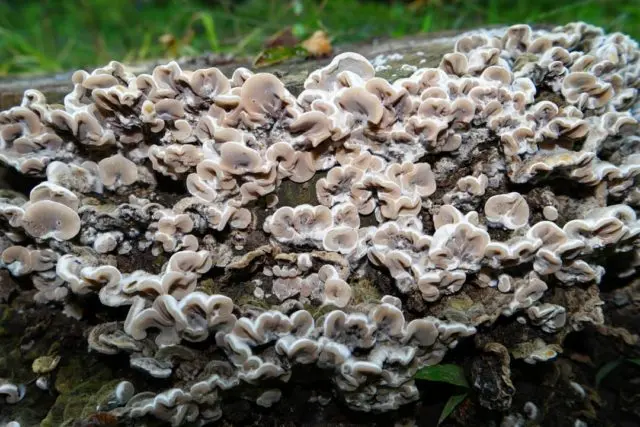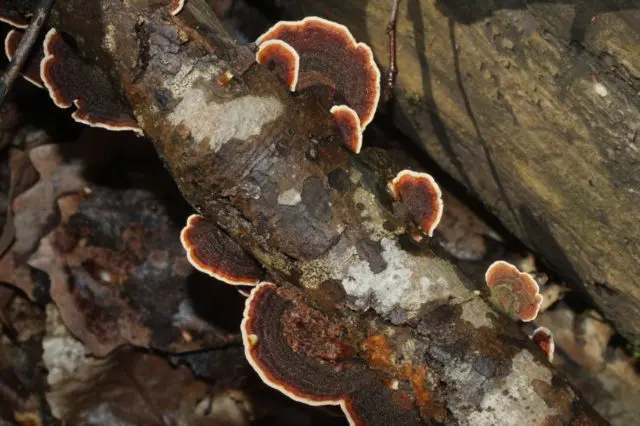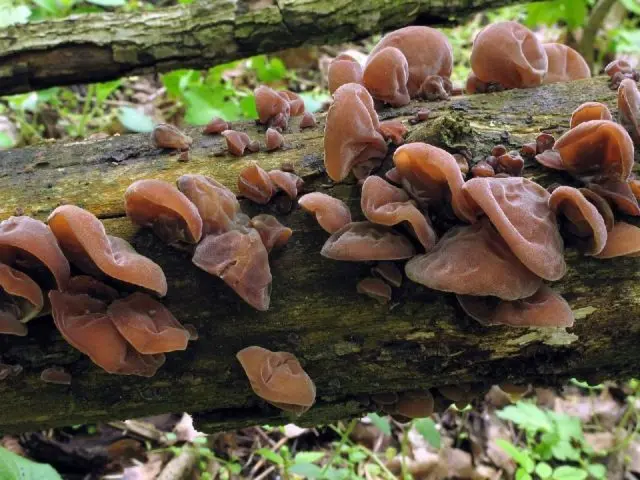Contents
Auricularia tortuous is a member of the family of the same name, whose representatives grow on wood in a warm temperate zone. Among mycologists, the fungus is also referred to as membranous auricularia, Auricularia mesenterica.
In addition to these names, there are others based on external similarities: intestinal auricularia, scar mushroom.

Due to the peculiarities of the structure and color of the wavy cap, the colonies of the auricularia sinuous resemble the waves of a seething stream.
Where does auricularia tortuous grow?
The membranous type of ear-shaped mushrooms is found in forests growing in lowlands near rivers, where there is a lot of moisture:
- on fallen hardwood trunks;
- prefer ash, poplar, elm;
- sometimes parasitic on living trees.
Less commonly, colonies of membranous auricularia settle on stumps. Fruiting bodies grow one after another in long ribbons. The species is common, fruiting bodies begin to form in summer, but remain in the warm regions of the temperate zone also in autumn and winter. Abundant fruiting begins in October-November, during winter thaws, as well as in early spring. It is distributed almost all over the world – in the humid areas of Europe, North America and Australia. In Our Country, the sinuous species is often found in the southern regions.
What does the auricularia sinuous look like?
Fruiting cartilaginous bodies of membranous appearance noticeable:
- height 15 cm;
- width up to 12-15 cm;
- thickness from 2 to 5 mm.
Like most tree mushrooms, the cap is semicircular, prostrate over time, similar to thin wavy plates with outlined light edges. On the skin, covered with grayish hairs, noticeable concentric stripes – semicircles, with alternating dark and light colors. The color of the skin on top can be different, depending on the type of tree and shading – from light gray to brown or greenish due to epiphytic algae. The leg is weakly expressed, sometimes absent.
Young mushrooms are small formations that are located along the length of the trunks after a few centimeters, then the colony merges. The lower surface of the fruiting body is wrinkled, veined, purple-brown or reddish. The elastic pulp is strong, during a drought it becomes hard and brittle. After the rains, it again becomes a gel-like state. Spore powder whitish.

As the distance between the bodies decreases, the colony spreads like a ribbon
Is it possible to eat auricularia tortuous
Among the representatives of the ear-shaped genus, there are no fruiting bodies with toxins, so they can be called conditionally edible. But the nutritional value, as well as the quality of the dishes, is low.
False doubles
A sinuous appearance, unlike other ear mushrooms, with a wavy cap and brightly colored concentric stripes. Only inexperienced mushroom pickers can accidentally confuse it with auricular auricularis, which is distinguished by smooth skin without folds and convolutions.

Edible ear mushrooms are distinguished by their bright brown-reddish color and delicate gel-like flesh.
Auricularia densely hairy is common in Our Country only in the Far East, and its distinguishing feature is rather high and noticeable hairs that cover the skin of the fruiting body.
Collection and consumption
The best harvesting season for young juicy curvy hats in regions with mild winters is from autumn to spring. Caps are eaten raw in salad, fried or salted. Taste and smell are weakly expressed. There is evidence that membranous auricularia, like related species, contributes to blood thinning in varicose veins.
Conclusion
Sinuous auricularia attracts mushroom pickers mainly in winter. Flat fruiting bodies are easier to cut with scissors. There are no poisonous false twins.









